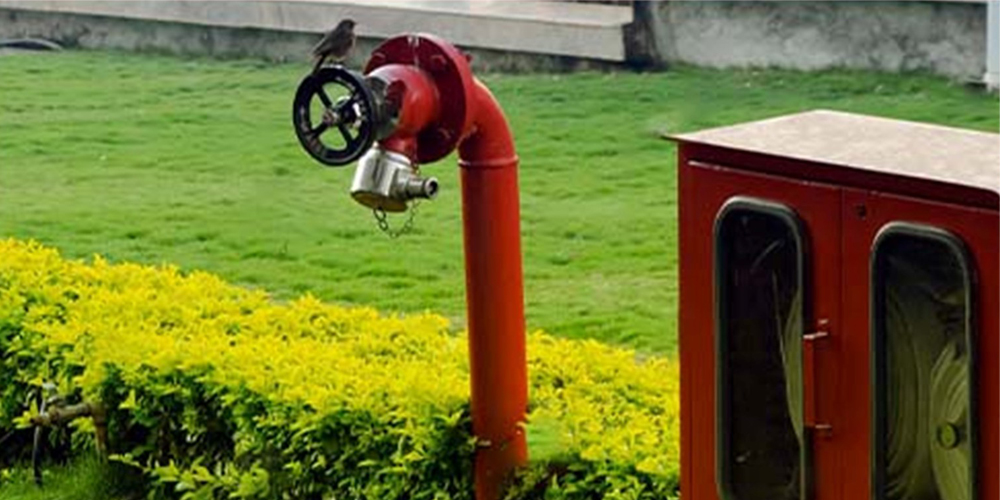
NR Square Enterprises is a Mumbai based, contractor offering wide range of Firefighting, Fire Alarm, Public Address, CCTV, Access Control services with different agencies, Site Survey, Designing of all kinds of Fire Fighting systems, Preparation of BOQ / Tender.
Currently NR Square Enterprises is working with Semi Government & leading private organizations. Our approach is to provide most reliable firefighting solutions and cost-effective services to our clients. As a dynamic leader we can provide a diverse range of top-quality services and installations all over India.
We are Specialized in:
Fire Hydrant System
A fire hydrant system, also known as a fire-fighting hydrant system or fire suppression system, is a network of pipes, valves, and hydrants designed to provide a ready source of water for firefighting purposes. It is an essential part of fire protection systems in buildings, industrial facilities, and public areas.
Components of a Fire Hydrant System:
Fire Hydrants: Hydrants are the visible above-ground components of the system. They consist of a water outlet and one or more valves. Firefighters can connect their hoses to the hydrants to access the water supply.
Underground Piping: A network of underground pipes connects the fire hydrants to a reliable water source, such as a municipal water supply or a dedicated water storage tank. These pipes carry water under pressure to the hydrants.
Water Supply: The fire hydrant system requires a sufficient and reliable water supply to ensure an adequate flow of water during firefighting operations. The water supply can come from the municipal water mains, dedicated storage tanks, or other approved sources.
Control Valves: Control valves are installed at various points in the system to control the flow of water. They allow the isolation of specific sections for maintenance or repairs and regulate the water pressure.
Pumping System: In some cases, a pumping system is incorporated into the fire hydrant system to boost the water pressure. This ensures that an adequate supply of water is available even if the existing pressure from the water source is insufficient.
Fire Department Connections: Fire department connections (FDC) are inlet points provided on the exterior of buildings or facilities. They allow fire departments to connect their fire engines or pumping apparatus directly to the fire hydrant system to augment the water supply.
Working of a Fire Hydrant System:
During a fire emergency, firefighters connect their hoses to the fire hydrants and open the hydrant valves to release water. The water flows from the hydrant, through the underground piping, and into the fire engine hoses. Firefighters then use the water to suppress the fire or protect nearby structures.
Importance of Fire Hydrant Systems:
Fire hydrant systems play a crucial role in fire protection and suppression. They provide a readily available water supply to firefighters, allowing them to respond quickly to fires. By having a well-designed and properly maintained fire hydrant system, the chances of effectively controlling and extinguishing fires are significantly improved, minimizing property damage and protecting lives.
It's important to note that specific regulations and requirements for fire hydrant systems may vary depending on local building codes, fire safety standards, and jurisdictional guidelines. Consulting with fire protection professionals and authorities in your area is crucial for designing, installing, and maintaining a fire hydrant system that meets the specific requirements of your location.
Fire Hydrant System application industries:
Fire hydrant systems are essential safety measures installed in various industries to protect lives and property in the event of a fire. Here are some industries where fire hydrant systems are commonly used:
Manufacturing and Industrial Facilities: Fire hydrant systems are extensively employed in manufacturing plants, including factories, warehouses, and processing units. These facilities often handle combustible materials, machinery, and large-scale operations, making fire protection crucial.
Commercial Buildings: Fire hydrant systems are prevalent in commercial complexes, such as shopping malls, office buildings, hotels, and restaurants. These buildings have high occupancy and foot traffic, increasing the risk of fire incidents and the need for an effective fire suppression system.
Residential Complexes: Large residential complexes, such as apartment buildings, gated communities, and housing societies, often incorporate fire hydrant systems. These systems provide a reliable source of water for firefighters during emergencies and enable efficient fire suppression in densely populated areas.
Hospitals and Healthcare Facilities:Healthcare institutions, including hospitals, clinics, and nursing homes, require robust fire safety measures to protect patients, staff, and medical equipment. Fire hydrant systems are an integral part of their fire protection strategy.
Educational Institutions: Schools, colleges, and universities install fire hydrant systems to ensure the safety of students, teachers, and staff. These systems help in containing and suppressing fires, allowing for a timely evacuation in educational settings.
Data centres and IT Facilities: Data centres house critical technological infrastructure and equipment, making them susceptible to fire risks. Fire hydrant systems are installed in these facilities to prevent damage to servers, storage systems, and other sensitive equipment.
Warehouses and Distribution centres: Fire hydrant systems are essential in large storage facilities where flammable materials, chemicals, and combustible goods are stored. These systems aid in early fire detection and effective fire suppression to mitigate potential losses.
Airports and Transportation Hubs: Fire hydrant systems play a vital role in airports, railway stations, and other transportation hubs. These facilities are characterized by high traffic and infrastructure complexity, necessitating reliable fire protection systems.
Power Plants and Utilities: Power generation facilities, including thermal power plants and substations, require fire hydrant systems to ensure the safety of personnel and prevent equipment damage. These systems are critical for suppressing fires in electrical installations.
Petrochemical and Refinery Complexes: Petrochemical plants, oil refineries, and similar facilities deal with highly flammable substances. Fire hydrant systems are integral to their fire safety infrastructure, enabling swift fire suppression in case of an emergency.
It's important to note that fire hydrant systems are just one component of a comprehensive fire safety plan, which may also include fire alarms, sprinkler systems, fire extinguishers, and evacuation protocols. The specific requirements and regulations for fire protection vary depending on the country, region, and industry standards.
